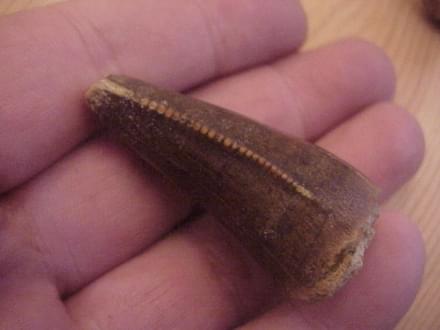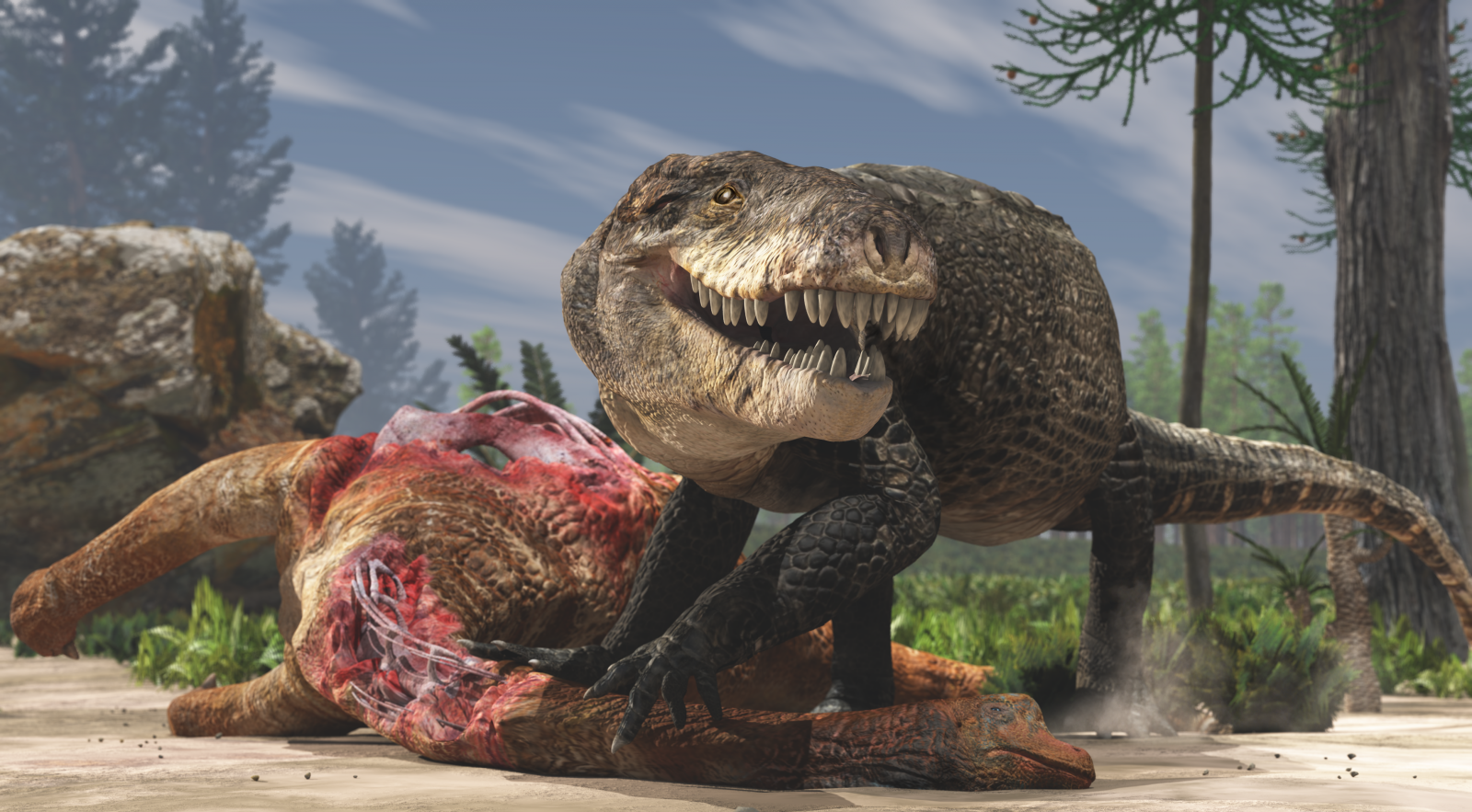|
|
Post by Infinity Blade on Aug 16, 2014 8:11:05 GMT 5
Razanandrongobe sakalavaeTemporal range: Middle Jurassic (Bathonian) Scientific classification Kingdom: AnimaliaPhylum: ChordataClass: SauropsidaSubclass: DiapsidaInfraclass: Archosauromorpha(unranked): ArchosauriaGenus: † RazanandrongobeSpecies: † R. sakalavaeA new large predatory archosaur from the Middle Jurassic (Bathonian) of MadagascarAbstract
Here we report on the finding of new vertebrate remains from the Middle Jurassic (Bathonian) of the Mahajanga basin, NW Madagascar, that represent one of the largest predatory archosaurs from Gondwana. The remains consist of a fragmentary right maxilla bearing three teeth and seven isolated teeth that clearly belong to a single taxon. Although the scarcity of the remains renders establishment of affinities difficult, the presence of a unique combination of features including a well developed medial shelf of the maxilla, rostral and lateral teeth respectively U-shaped and sub-oval in cross-section, and very large tooth denticles (1 per mm), allows us to erect a new taxon, Razanandrongobe sakalavae. Additionally, the structure of the teeth, the peculiar wear of their enamel, and the morphology of the maxilla strongly suggest that Razanandrongobe sakalavae often crushed the bones of its prey.       
|
|
|
|
Post by Infinity Blade on Aug 16, 2014 18:02:44 GMT 5
|
|
|
|
Post by Infinity Blade on Jan 15, 2015 7:00:08 GMT 5
I was looking through the SVP 2014 pdf and I found this.......yes......just yes. New Cranial Remains of the Enigmatic Archosaur Razanandrongobe sakalavae from the Middle Jurassic of Madagascar Clarify its Phylogenetic RelationshipsDAL SASSO, Cristiano, Museo di Storia Naturale di Milano, Italy; MAGANUCO, Simone, Museo di Storia Naturale di Milano, Italy; FLEURY, Guillaume, Muséum d'Histoire Naturelle, Toulouse, France " Razanandrongobe sakalavae is a large predatory archosaur of uncertain affinities that was diagnosed on the basis of fragmentary maxilla and teeth, from the Middle Jurassic (Bathonian) of the Mahajanga basin, NW Madagascar. Here we describe two new cranial elements which greatly improve our knowledge of this enigmatic species. The almost complete right premaxilla indicates that the rostrum is deep, wide, and not pointed, with four alveoli that are sub-vertical, just slightly curved lingually. The external nares are confluent and face rostrally. The premaxilla lacks any lateral groove at premaxillomaxillary suture for reception of mandibular fangs. The left dentary is incomplete caudally. The preserved portion bears eight large mandibular teeth of similar size, none of which is a hypertrophied fang. The mandibular symphysis extends posteriorly to level of the eighth tooth. The splenial itself is not preserved, but its sutural marks on the dentary indicate that the splenial contribution to the mandibular symphysis is approximately one fifth of the symphyseal length in dorsal aspect.
On the basis of the new data, some previously uncertain features of the holotypic maxilla, such as the margin of the suborbital fenestra and the contact surfaces for the palatine, the ectopterygoid and the jugal, are now apparent. The phylogenetic relationships of the species within Archosauriformes are tested. The results confirm that R. sakalavae is a valid species, nested at the base of Mesoeucrocodylia and is distinct from any currently known member of the taxon. A cranial reconstruction is attempted, informed by the results of the phylogenetic analysis." vertpaleo.org/PDFS/9c/9ce46057-c8cc-45f2-95ae-767eb679dafd.pdf(pages 115-116 if you go by the numbers given on the bottom corners of the pages) |
|
|
|
Post by Infinity Blade on Jul 5, 2017 7:14:45 GMT 5
Gigantic crocodile with T. rex teeth was a top land predator of the Jurassic in Madagascar Little is known about the origin and early evolution of the Notosuchia, hitherto unknown in the Jurassic period. New research on fossils from Madagascar, published in the peer-reviewed journal PeerJ by Italian and French paleontologists, begin to fill the gap in a million-year-long ghost lineage. Deep and massive jaw bones armed with enormous serrated teeth that are similar in size and shape to those of a T-rex strongly suggest that these animals fed also on hard tissue such as bone and tendon. The full name of the predatory crocodyliform (nicknamed 'Razana') is Razanandrongobe sakalavae, which means "giant lizard ancestor from Sakalava region". A combination of anatomical features clearly identify this taxon as a Jurassic notosuchian, close to the South American baurusuchids and sebecids, that were highly specialized predators of terrestrial habits, different from present-day crocodilians in having a deep skull and powerful erect limbs. "Like these and other gigantic crocs from the Cretaceous, 'Razana' could outcompete even theropod dinosaurs, at the top of the food chain", says Cristiano Dal Sasso, of the Natural History Museum of Milan. Razanandrongobe sakalavae is by far the oldest—and possibly the largest—representative of the Notosuchia, documenting one of the earliest events of exacerbated increase in body size along the evolutionary history of the group. "Its geographic position during the period when Madagascar was separating from other landmasses is strongly suggestive of an endemic lineage. At the same time, it represents a further signal that the Notosuchia originated in southern Gondwana", remarks co-author Simone Maganuco. phys.org/news/2017-07-gigantic-crocodile-rex-teeth-predator.html---------------------------------------------------------------------------------------------------------- Razanandrongobe sakalavae, a gigantic mesoeucrocodylian from the Middle Jurassic of Madagascar, is the oldest known notosuchianCristiano Dal Sasso, Giovanni Pasini, Guillaume Fleury, Simone Maganuco Razanandrongobe sakalavae (Maganuco, Dal Sasso & Pasini, 2006) is a large predatory archosaur from the Middle Jurassic (Bathonian) of the Mahajanga Basin, NW Madagascar. It was diagnosed on the basis of teeth and a fragmentary maxilla, but its affinities were uncertain. Here we describe new cranial remains (above all, an almost complete right premaxilla and a caudally incomplete left dentary) that greatly improve our knowledge on this enigmatic species and reveal its anatomy to be crocodylomorph. The right premaxilla indicates that the rostrum was deep, wide, and not pointed; it bears five teeth that are sub-vertical and just slightly curved lingually; the mesial teeth are U-shaped in cross-section and have serrated carinae on the lingual side; the aperturae nasi osseae (external bony nares) are confluent and face rostrally; and there is no lateral groove at the premaxillomaxillary suture for reception of a hypertrophied lower caniniform tooth. The preserved portion of the left dentary has an edentulous tip and bears eight large mandibular teeth of which the mesial (1–3) are the largest, but none is a hypertrophied caniniform tooth; the mandibular (dentary) symphysis extends caudally to the level of the third tooth; the splenial is not preserved, but its sutural marks on the dentary indicate that it contributed to the mandibular symphysis for at least 20% of the symphyseal length in dorsal aspect. On the basis of this new data, some previously uncertain features of the holotype maxilla—such as the margin of the suborbital fenestra, the contact surfaces for the palatine, the ectopterygoid, and the jugal—are now apparent. Testing of the phylogenetic position of the species within Crocodylomorpha indicates that R. sakalavae is a mesoeucrocodylian. It also represents one of the earliest events of exacerbated increase in body size along the evolutionary history of the group. In addition, it is by far the oldest notosuchian. A cranial reconstruction of this gigantic predator is also attempted here. The very robust jaw bones of R. sakalavae, coupled with its peculiar dentition, strongly suggest a diet that included hard tissue such as bone and tendon. peerj.com/articles/3481/
|
|